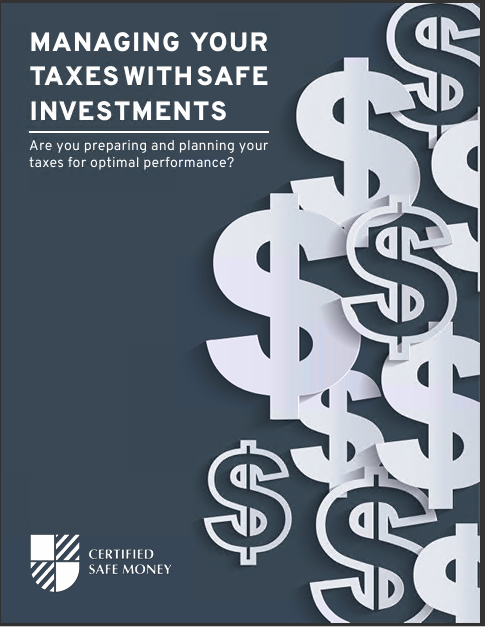Safe Money Advice and Strategies – Federal Employee and TSP Safe Money Strategies
Employees of the federal government may be eligible for retirement savings benefits. One option is the Thrift Savings Plan (TSP). You could attain tax-advantaged savings, as well as a reliable income stream in retirement if you participate in the TSP.Understanding how the TSP plan works and knowing about the funding alternatives that are offered can help you determine which of these financial “tools” could best help you meet your specific retirement income goals.
What is the Thrift Savings Plan, and How Does It Work?
The Thrift Savings Plan (TSP) is a retirement savings plan for federal employees and members of the uniformed services. In many ways, the TSP is similar to the 401(k) plan that is offered through private corporations.Contributions go into the traditional Thrift Savings Plan pre-tax. This means that participants will not be taxed on those dollars until the funds are withdrawn. Likewise, money in the TSP plan grows on a tax-deferred basis. So, there is no tax on the growth in the account until the time of withdrawal, too.Similar to many private company retirement plans, TSP participants may receive a matching contribution from their agency. Therefore, this “free money” can also increase the value of the account.There is an annual maximum contribution limit imposed by the Thrift Savings Plan. For 2021, plan participants who are age 49 and younger can contribute up to $19,500. Those who are age 50 and older are allowed to contribute an additional $6,500 for a total annual contribution of $26,000.
Annual Maximum Contribution Limits for the Thrift Savings Plan (in 2021)
2021 Contribution Limit2020 Contribution LimitElective Deferral Limit$19,500$19,500Catch-up Contribution Limit (for participants who are age 50 and older)$6,500$6,500Source: TDP Bulletin for Agency and Service TSP RepresentativesContributions into the TSP Savings Plan are made via payroll deduction. So, it is necessary for participants to make an election through their agency to begin TSP contributions (unless they are enrolled automatically) and change the contribution or stop contributing to the plan altogether.
Traditional TSP versus Roth TSP
As with personal IRAs (Individual Retirement Accounts), Thrift Savings Plan participants have the option for both traditional and Roth options. For many years, only the traditional TSP was available. In this plan, contributions go into the plan pre-tax, and gains are tax-deferred.When withdrawals are made, 100% of the money accessed will be taxable. (This is because none of these dollars has yet been subject to income taxation.) The amount of tax incurred can impact how much net spendable income is left over for paying expenses in retirement.As an alternative, there is also a Roth TSP available. These contributions that go into the Roth plan have already been subject to income tax. However, the account grows tax-free, and withdrawals are also free of tax, regardless of the then-current income tax rates.It is important to be mindful of just how much taxes could reduce spendable retirement income. For example, since the year 1913, the top federal income tax rate has been 70% or more 49 times, and in some years, as much as 94%. With that in mind, discussing the pros and cons of the traditional versus the Roth Thrift Savings Plan options with a retirement financial advisor can help you to decide which is right for you.
Top Federal Income Tax Rates 1913 – 2021
YearRateYearRate2018-202137195084.362013-201739.61948-194982.132003-2012351946-194786.45200238.61944-194594200139.11942-1943881993-200039.61941811991-199231194081.11988-1990281936-193979198738.51932-1935631982-1986501930-193125198169.1251929241971-1980701925-192825197071.75192446196977192343.5196875.251922581965-1967701919-1921731964771918771954-1963911917671952-1953921916151951911913-19157Source: Inside GovIt is important to note that TSP plan participants do not have to put 100% of their money into one option. So, having some funds in a traditional TSP and some in a Roth TSP plan is not uncommon.
Traditional TSP versus Roth TSP
The Treatment of:Traditional TSPRoth TSPContributionsPre-taxAfter-taxPaycheckTaxes are deferred, so less money is taken out of the participant’s paycheck.Taxes are paid upfront, so more money comes out of the participant’s paycheck.Transfers InTransfers are allowed from eligible employer plans and traditional IRAs.Transfers are allowed from Roth 401(k)s, Roth 403(b)s, and Roth 457(b)s.Transfers OutTransfers are allowed to eligible employer plans, traditional IRAs, and Roth IRAs.Transfers are allowed to Roth 401(k)s, Roth 403(b)s, Roth 457(b)s, and Roth IRAs.WithdrawalsTaxable when withdrawn.Tax-free earnings if five years have passed since January 1st of the year the participant made their first Roth contribution, and they are age 59 or older, permanently disabled, or deceased.Source: www.tsp.gov
TSP Fund Options
There are several fund options available through the Thrift Savings Plan. These funds have different objectives, such as growth, safety, and balance. It is important to understand how each fund works, and the potential for risk in each one before you determine which one(s) are right for you.G FundThe G Fund is the most conservative of all the options available to TSP participants. It consists of a non-marketable United States Treasury security that offers both principal and interest, which the U.S. government guarantees. As with many “safe” financial vehicles, though, the rate of return that is offered through the G Fund is low.F, C, S, and I FundsThe F, C, S, and I Funds are all index funds. So, they offer the opportunity for growth based on how the underlying index performs. BlackRock Institutional Trust Company, N.A. manages these four TSP funds.Because index funds can have many “moving parts,” you should have a good understanding of how the returns are calculated so that you know what you can and can’t anticipate regarding performance.L Funds / Lifecycle FundsThe L Funds are also referred to as Lifecycle Funds. There are currently 10 L Funds available. These each constitute a mix of the five “core” TSP funds, including Fund G, F, C, S, and I). The L Funds were designed so that TSP participants could invest their entire portfolio in just one fund rather than diversify independently.Each quarter, the L Funds’ (with the exception of the L Income Fund) target allocations are adjusted automatically. This adjustment gradually shifts the funds from higher risk (and higher potential return) to lower risk as the participant gets closer to retirement.L Funds also have “target dates.” This means that the fund will eventually go out of existence. At that time, funds invested in the “expired” L Fund will be moved to the L Income Fund – which typically maintains the same target allocation.It is important to keep in mind that each of the L Funds sticks with their target allocation for a full three months, regardless of what happens in the stock market. So, there is no automatic adjustment made based on performance alone.You can compare different Lifecycle Funds (L Funds) and the individual funds (G, F, C, S, and I) on the Thrift Savings Plan’s website. You can do so by going to https://tsp.gov/funds-lifecycle/.Before you decide which of the TSP funds are right for you, it can help to discuss your short- and long-term financial goals with an advisor who is well-versed in the federal employee retirement plan options. That way, you can better coordinate your employer-sponsored and personal savings and retirement income options.
How to Make TSP Plan Withdrawals
There are three primary methods for withdrawing funds from your Thrift Savings Plan account. These include:
- Installment payments (monthly, quarterly, or annually)
- Single/lump sum withdrawals
- Annuity income payments (which include a lifetime income feature that will continue to pay, regardless of how long you may live)
You may opt for one of these methods, or you could choose any combination of them. There is no limit on the number of withdrawals you can take after you have retired.If you stop working for the federal government, you can begin making TSP withdrawals when you are age 55 or older without incurring a penalty. If the federal government still employs you, you must wait until you are at least age 59 to make penalty-free withdrawals from the Thrift Savings Plan.However, you may be able to make an in-service withdrawal from the Thrift Savings Plan while you are still employed in federal civilian service or in the uniformed services. There are two types of in-service withdrawals available. These are:
- Financial hardship withdrawal
- Age-based 59 withdrawal
A financial hardship withdrawal is one that you make because of a genuine financial need. This could include the need for emergency funds, a costly medical issue, personal casualty losses (such as damage or destruction to your home because of a natural disaster), and certain types of legal expenses.Before you make an in-service withdrawal, keep in mind that the TSP is a retirement savings account. So, any withdrawals you make before retirement could have a negative impact on what you have available from the TSP plan in the future.You will also have to pay federal and, in some cases, state income taxes on the taxable portion of the TSP withdrawal. Plus, if you do so before you have turned age 59 , you may also incur an additional 10% “early withdrawal” penalty from the IRS.Note that it could take up to eight weeks for the TSP Service Office to process a Thrift Savings Plan withdrawal. If you have separated from service or have no other incoming cash flow, be sure that you know this time frame.
What Happens With TSP Funds When a Plan Participant Dies?
As a TSP plan participant, you should designate one or more beneficiaries who can receive these funds in the event of your death. If you have not named any beneficiaries, the payment from your plan would be made in the following order:
- Widow or widower
- If none of the above, your child or children and descendants of deceased children by representation
- If none of the above, your surviving parent(s)
- If none of the above, the executor or administrator of your estate
- If none of the above, to any other of your next of kin who is entitled under the laws of the state where you resided at the time of your passing.
Do You Still Have Questions About the TSP?
Participating in the TSP plan can provide you with financial security in the future. Many benefits can be gained by participating, such as:
- Ease of enrollment in the plan
- Low costs (especially compared to charges and fees as an individual investor)
- Matching contributions from your agency
- Tax advantages (such as tax-deferred or tax-free growth on funds in the account)
- Variety of different investment options.
Often, though, when there are many available alternatives, it can become somewhat overwhelming. So, if you still have questions about the Thrift Savings Plan, or if you would like to determine how best to coordinate the TSP with your other retirement savings, it is recommended that you talk with a retirement financial advisor who is well-versed in federal benefits.Please feel free to reach out to us directly at info@certifiedsafemoney.com. We look forward to helping you with your retirement savings and income-generating strategies.













